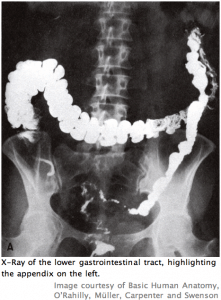The function of the human appendix has long been a puzzle. The thin pouch branching off at the beginning of the large intestine appears to serve no purpose; in long-term studies, patients who have received appendectomies show no ill effects. And so, even healthy appendices are regularly removed during many completely unrelated surgeries. In the words of anatomist Alfred Romer, it would seem the appendix’s main function is “financial support of the surgical profession” (1).
In his 1849 book, The Descent of Man, Charles Darwin suggested that the appendix might be a vestigial structure – a part of the digestive system that was useful at some earlier point in evolution, but has since lost its purpose. This seems to be the commonly held view among the general public. But there are problems with it. For example, an appendix is found in rabbits, wombats, and opossums, as well in the primates. This erratic pattern of appearances throughout evolutionary taxa suggests that the appendix is not vestigial and does indeed serve some purpose (1). But what is it?
Recent research at Duke University may begin to answer this question. After an examination of the bacteria living in the appendix and large intestine, the researchers concluded that the appendix functions as a storage place for the good bacteria needed in the intestinal tract. According to William Parker, a co-author of the study, when a disease infects the intestines the appendix “acts as a good safe house for bacteria” (2). With a disease like dysentery, gut flora can be completely flushed from the intestine through diarrhea. When this happens, the bacteria living in the appendix can repopulate the intestinal tract (3).
The study relied on an assessment of the biofilms present in the human intestine. A biofilm is a colony of bacteria living together on a solid surface or on an extracellular matrix produced by some other organism. They are common in many species: plants release sugars to support biofilms in their roots, which may assist in absorbing nutrients; corals secrete a mucus matrix to provide a home for biofilms that ward off harmful bacteria; even dental plaque is a biofilm (4).
The Duke University team found high concentrations of biofilms in the appendix, with fewer and fewer further down the intestinal tract towards the rectum. But this didn’t appear to jive with earlier research on the appendix – it had been suggested that the appendix plays a role in the immune system, as evidenced by its high numbers of infection-fighting lymphoid cells (3). But if the appendix is an immune system organ, why is it full of bacteria?
 The answer can be found in the most commonly produced glycoprotein in the human body: secretory immunoglobulin A, or sIgA. sIgA is an antibody secreted in great quantities by lymph tissue in the intestines, in order to protect against pathogenic bacteria. But the mechanism of this protection was not understood until recently (5).
The answer can be found in the most commonly produced glycoprotein in the human body: secretory immunoglobulin A, or sIgA. sIgA is an antibody secreted in great quantities by lymph tissue in the intestines, in order to protect against pathogenic bacteria. But the mechanism of this protection was not understood until recently (5).
It turns out that sIgA actually promotes biofilm formation in the intestine. Bacteria are better able to cluster together, as well as adhere to the intestinal wall, when sIgA is present. This seems to present a contradiction to sIgA’s role in the immune system – but in fact, sIgA just fights pathogens indirectly. It promotes clustering and biofilm formation among normal gut bacteria, and these thick biofilms make it difficult for foreign pathogens to breach the epithelial barrier (5). So the appendix’s multitude of lymphoid cells may actually act to increase its concentration of bacteria (3).
The final clue to the appendix’s proposed role is its location in the digestive tract. As an offshoot of the cecum, at the beginning of the large intestine, it is relatively secluded from the flow of fecal matter. This seclusion, combined with the appendix’s narrow opening, keep it safe from contamination by pathogens, making it an excellent “safe house” for gut flora (3).
The researchers from Duke proposed that some of the biofilms in the appendix regularly slough off and flow down the digestive tract. In the event of an infection that wipes out gut flora, it is these offshoot bacterial colonies that will repopulate the intestine (3).
So perhaps the appendix will no longer be viewed as a useless vestige of an earlier time. However, there is still the fact that appendectomies cause no detrimental effects – doesn’t this demonstrate pretty clearly that the appendix has no purpose? Well, sort of. In industrialized societies, modern medicine and food sanitation practices have practically eliminated the risk of intestine-flushing diseases like dysentery. So for the average American, this new study does not actually change the appendix’s status – it is still useless (3).
However, in developing countries, the typical diet is less sanitary, and infections of the digestive tract are far more common. There, the appendix still serves its purpose (3).
As modern medical and sanitation practices spread throughout the globe, perhaps the appendix will come to hold no value to anyone – a truly useless vestige. But until that day, a little pride is in order; the world has finally recognized the value of the appendix.
References:
1. D. Theobald, The vestigiality of the human vermiform appendix (2007). Available at: http://www.talkorigins.org/faqs/vestiges/appendix.html (4 November, 2007).
2. “Scientists may have found appendix’s purpose” Associated Press (2007). Available at: http://www.msnbc.msn.com/id/21153898/index.html (4 November 2007).
3. R. Bollinger, A. Barbas, E. Bush, J. Theoretical Biology 249, 826 (2007).
4. Dr. John Lennox and Montana State Center for Biofilm Engineering, A Biofilm Primer (2006). Available at http://www.biofilmsonline.com/cgi-bin/biofilmsonline/ed_intro_primer.html (5 November, 2007).
5. M.Everett, D. Palestrant, S. Miller, R. Bollinger, Clinical and Applied Immunology Reviews 4, 321 (2004).